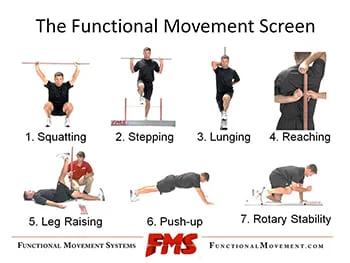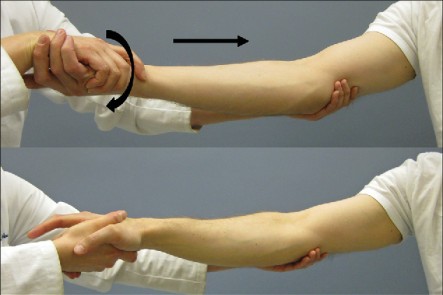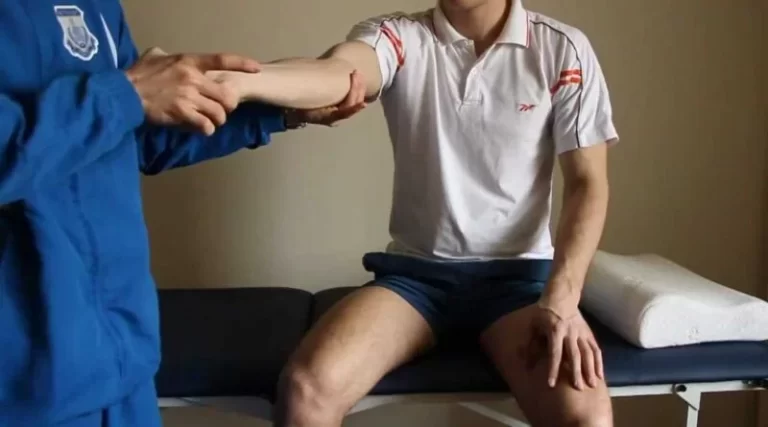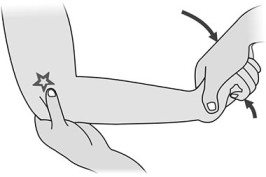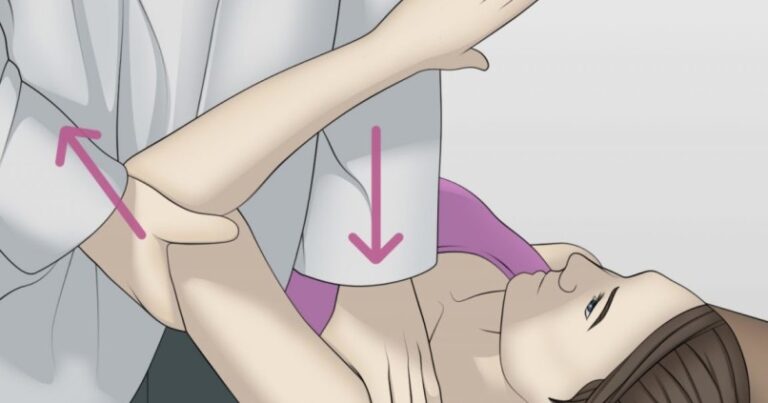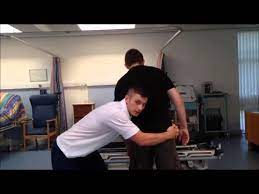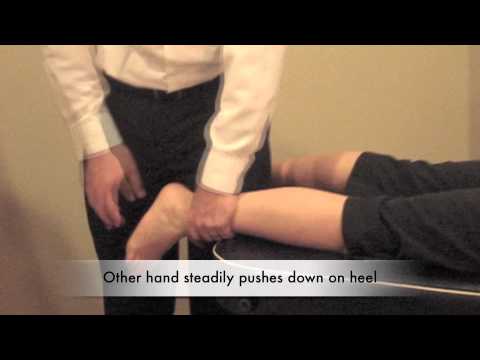Functional Movement Screen (FMS)
What is a Functional Movement Screen (FMS)?
The Functional Movement Screen (FMS) is a widely recognized and systematic approach used by fitness professionals, physical therapists, and sports trainers to assess an individual’s fundamental movement patterns and identify any limitations or dysfunctions in their movement. Developed by Gray Cook and Lee Burton, the FMS aims to evaluate the quality of basic movements that are essential for daily activities and sports performance.
The FMS consists of a series of seven fundamental movement patterns that are scored on a scale to help determine an individual’s movement competency. These patterns include squatting, lunging, bending, twisting, reaching, and core stability exercises. By assessing these movements, the FMS provides valuable insights into an individual’s mobility, stability, and coordination.
The FMS looks for mobility and stability abnormalities during seven basic movement patterns. These movement patterns are made to put a person in extreme positions where deficits and imbalances become apparent if sufficient mobility and motor control are not used, in order to offer observable execution of basic locomotor, manipulating, and stabilizing motions. Following the FMS’s identification of these weaknesses, a program of corrective exercises is created with the intention of avoiding musculoskeletal disorders.
Seven movement patterns that make up the FMS require for both flexibility and stability. The scores for the next seven movement patterns range from 0 to 3, adding up to a total of 0 to 21 points.
The 7 Movement Patterns are:
- Deep Squat
- Hurdle Step
- In-line Lunge
- Active Straight-leg Raise
- Trunk Stability Push-up
- Rotary Stability
- Shoulder Mobility
Deep Squat
The Deep Squat pattern tests both neuromuscular control and overall body mechanics. We employ it to evaluate the functional mobility and stability of the hips, knees, and ankles on a bilateral, symmetrical basis.
The shoulders, scapula, and thoracic spine must be bilaterally symmetrically mobile and stable to do the dowel overhead. To complete the full pattern, the pelvis and core must maintain stability and control throughout the entire movement.
Hurdle Step
The hurdle step pattern is essential to both acceleration and movement. This exercise tests stability and control while putting the body’s step and stride mechanics to the test. The hips, knees, and ankles need to be bilaterally mobile and stable for the hurdle step. As it provides a chance to see functional symmetry, the test also puts the pelvis and core through their paces in terms of stability and control.
Inline Lunge
The Inline Lunge pattern puts the body in a position to imitate rotational, lateral, and deceleration loads. The inline lunge positions the upper extremities in an opposing or reciprocal pattern while the lower extremities are in a splitstance. Since it specifically necessitates spine stabilization, it mimics the natural counterweight that the upper and lower extremities utilize to balance one another. This examination also tests the stability and mobility of the hip, knee, ankle, and foot.
Shoulder Mobility
The Shoulder Mobility pattern shows how the scapular-thoracic region, thoracic spine, and rib cage naturally complement one other during reciprocal upper-extremity shoulder movements. Along with observing the range of motion in both shoulders, this pattern combines flexion, external rotation, and abduction in one extremity with extension, internal rotation, and adduction in the other.
Active Straight-Leg Raise
The Active Straight-Leg Raise pattern examines the core stability within the pattern as well as the alternate hip’s accessible hip extension in addition to identifying the active mobility of the flexed hip. This assessment of the capacity to separate the lower extremities in an unloaded position is more important than testing hip flexion on one side. The capacity to disassociate the lower extremities while retaining core and pelvic stability is put to the test by this pattern as well.
Trunk Stability Push-Up
Stability of the trunk The push-up pattern is not a test or a way to evaluate upper body strength; rather, it is utilized as a fundamental observation of reflex core stabilization. The objective is to start moving in a push-up pattern with the upper extremities while preventing movement in the spine or hips. The movement assesses the capacity to maintain spinal stability in the sagittal plane during the upper body symmetrical, closed kinetic chain movement.
Rotary Stability
The complicated Rotary Stability pattern demands effective torso energy transmission and neuromuscular synchronization. This pattern observes multi-plane stability of the pelvis, core, and shoulder girdle during a joint movement of the upper and lower extremities. It shows the combined efforts of mobility and stability seen in basic climbing patterns and exhibits reflex stabilization and weight shifting in the transverse plane.
Scoring Criteria
The FMS has a simple grading method. Every movement pattern has specific requirements that must be met in order to receive a high score. Four fundamental factors form the basis for the scoring:
3 score-
If the person can carry out the movement in accordance with the set criteria without the need for any adjustments, they receive a score of three.
2 score-
Two is given if the person can carry out the exercise but must do so with substandard mechanics and compensatory practices.
1 score
If the person is unable to carry out the movement pattern despite using compensations, one is given.
0 score
If the person experiences any pain while doing the movement, a score of zero is given.
Intended Population
The FMS was created to be a screening tool for people who may have functional mobility deficiencies, which could point to a higher risk of injury. Young, energetic people to middle-aged people, elite collegiate and professional athletes, as well as members of the military and firefighters, are all used in the literature. Lower FMS scores have been found to be correlated with higher BMI, older age, and lower levels of activity.
Use of Functional Movement Screen (FMS)
The cut-off point on the FMS is a score of <=14. People who receive fewer than 14 on the FMS screen have a higher chance of getting hurt.
Due to a lack of research to date, it is unclear whether sports or professions the FMS predicts injury risk for best and whether the original cutoff score of =14 is reliable across populations.
Reliability
The FMS screen has a high level of dependability, according to numerous studies.
According to a recent study by Teyhen et al, the FMS showed moderate to good inter-rater and intra-rater reliability among beginner raters, even with only four hours of training.
Validity
Although preliminary research by Kiesel et al. indicates that NFL (National Football League) players who score = 14 on the FMS had a positive likelihood ratio of 5.8 to suffer an injury that resulted in time-loss. There are still questions about the FMS’s reliability.
According to Moran et al., the FMS composite scores’ strength of relationship with later injury does not justify the use of the scores as an injury prediction tool. Additionally, Alemany et al. argue that pain incidence may be a more reliable predictor of injury risk than a low composite score and that this strategy is less complex than using the whole FMS.
FMS vs. SFMA
The Selective Functional Movement Assessment (SFMA) and the Functional Movement Screen instrument are frequently confused by doctors. Although they are both components of the same Functional Movement System developed by Cook and colleagues, the two tools serve quite distinct primary objectives.
The SFMA is intended to be used in a diagnostic capacity and is made to spot musculoskeletal dysfunction in those who are experiencing pain. The FMS, however, is only meant to be used as a screening tool. The FMS seeks to locate mobility and stability abnormalities during functional motions.
Summary
The Functional Movement Screen has gained popularity in various fields, including sports conditioning, rehabilitation, and general fitness, as it provides a structured framework for assessing and addressing movement issues, ultimately promoting better health and athletic performance.
References
[Functional Movement Screen (FMS)]. (n.d.). https://www.functionalmovement.com/files/Articles/572a_FMS_Article_NoBleed_Digital.pdf.
Functional Movement Screen (FMS). (n.d.). Physiopedia. https://www.physio-pedia.com/Functional_Movement_Screen_(FMS)

